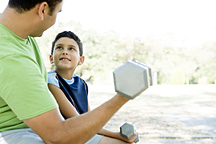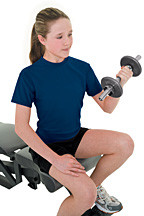Exercise, fitness, and sport-specific training are more popular than ever, and interest and participation aren’t limited to the adult crowd. Gyms and health facilities are flooded with parents wanting to give their kids the competitive advantage. There is increasing societal pressure for kids to look a certain way physically or perform a certain way on the playing field. The desire to be number one can set the stage for improper training, overtraining and injury.
Kids pick up the latest fitness magazine and start training like their favorite athletes do, thinking they can be just like them if they push hard enough. Unfortunately, their bodies are usually not ready for this level of training, and they can easily develop abnormal patterns of muscle movement and function. These abnormal patterns inhibit athletic performance and, if left uncorrected, may cause permanent injury. Let’s review the five biggest exercise mistakes youngsters can make, along with some safe and effective alternatives.
Mistake #1: Starting Weight Training Too Soon
 The Wrong Way: The number-one cause of injuries and poor performance (by far) is improper weight training. Introducing weight resistance training too soon causes abnormal vector stresses on the growth plates in bones, elevating injury risk significantly. Although injuries can occur at any age, youngsters in their preteen and early teen years are particularly vulnerable, especially to vigorous, repetitive movement, because of the way their bones grow. Ligaments and tendons are also prone to irritation and tearing when muscles shorten, causing lack of mobility and stability.
The Wrong Way: The number-one cause of injuries and poor performance (by far) is improper weight training. Introducing weight resistance training too soon causes abnormal vector stresses on the growth plates in bones, elevating injury risk significantly. Although injuries can occur at any age, youngsters in their preteen and early teen years are particularly vulnerable, especially to vigorous, repetitive movement, because of the way their bones grow. Ligaments and tendons are also prone to irritation and tearing when muscles shorten, causing lack of mobility and stability.
According to Mike Silva, a personal trainer (and owner/director of Edge Fitness in Ramsey, N.J.) who specializes in training young athletes, “The most commonly injured joint in youngsters is the shoulder rotator cuff. Because of all of the pressing and pushing movements involved with weight training on still-developing tissues, the rotator cuff can’t stabilize properly.
“There is always a sacrifice of exercise quality for more quantity in weight training. Kids are so programmed to reach a certain number of repetitions or sets that they neglect proper form. Weight training should always be under the supervision of a personal trainer skilled in working with youth.”
The Right Way: So, what is a safer and more effective way of getting stronger without weight training? The answer is so simple, yet so effective and easy to do anywhere: body-weight training, which is a fundamental way to build stamina, strength, power and speed. Examples of body-weight training include the basics: push-ups, sit-ups, pull-ups, squats, lunges and sprints.
Mistake #2: Ignoring Flexibility and Stability
The Wrong Way: Lack of proper stretching before and after physical exercise is a primary cause of unnecessary injury. Adults are even guilty of ignoring this important component of any exercise routine, but kids are even worse. The body must be properly warmed up and primed for maximum physical performance and recovery. Without proper blood flow and joint lubrication, the risk of injury is drastically increased. Too often, people who do stretch use static stretch-and-hold techniques; if they go beyond comfortable limits, this type of stretching can actually put the muscle at risk of tearing due to the body’s inherent self-protective guarding mechanism.
 The Right Way: The most effective stretching techniques for athletes of any age are called myofascial release and active isolated stretching. These are the “secret weapons” of professional athletes looking to increase performance and reduce injury risk. While you may not have heard of these techniques by name, you’ve probably seen them in action at the gym or on fitness-oriented TV shows.
The Right Way: The most effective stretching techniques for athletes of any age are called myofascial release and active isolated stretching. These are the “secret weapons” of professional athletes looking to increase performance and reduce injury risk. While you may not have heard of these techniques by name, you’ve probably seen them in action at the gym or on fitness-oriented TV shows.
Myofascial release involves rolling muscles over a cylindrical foam tube to increase blood flow and tissue flexibility. Active stretching uses ropes or bands to elongate muscles and prevent over-lengthening and tearing. I have used this effective combination of massage and stretching for years with all of my athlete patients and cannot recommend it highly enough. Taking just five minutes before exercise or competition to perform these techniques may prevent a life-altering injury from occurring.
Mistake #3: Overtraining
The Wrong Way: The body grows and recovers with rest, not from exercise itself. In this fast-paced, on-the-go world, youngsters are always on the move, hardly taking a moment to rest. They go from one activity to the next and get increasingly less sleep and time for true relaxation. Add the stresses of intense exercise, and you push the body to the brink of breakdown.
Hard training breaks you down and makes you weaker. Rest makes you stronger. Physiologic improvement only occurs during the rest period following hard training. If sufficient rest is not included in a training program, regeneration cannot occur and performance plateaus. If this imbalance between excess training and inadequate rest persists, performance will decline. “Overtraining syndrome” is the name given to the collection of chronic (persisting for weeks, months or even longer) emotional, behavioral, and physical symptoms due to overtraining. Athletes know it as “burnout.” Overtraining is marked by cumulative exhaustion that persists even after recovery periods, and makes the body more prone to injury.
The Right Way: Ensuring adequate rest and recovery is the best way to avoid overtraining syndrome and its consequences. The longer the overtraining takes place, the more rest is required. Therefore, early detection is very important. No matter how interested your child is in exercise and fitness, you have to help them temper that enthusiasm to avoid burnout and injury. As with all things, exercise-related and otherwise, moderation is the key.
If the overtraining has only occurred for a short period of time (e.g., 3- 4 weeks) then interrupting training for 3-5 days is usually sufficient rest. After this, workouts can be resumed on an every-other-day basis. The intensity of the training can be maintained, but the total volume should be lower. It is also important that the factors which led to overtraining be identified and corrected. Otherwise, the overtraining syndrome is likely to recur. An alternate form of exercise can be substituted to help prevent the exercise withdrawal syndrome. You do not need to eliminate all forms of exercise; simply reduce the intensity and allow for proper recovery.
Mistake #4: Unsupervised Group Training
 The Wrong Way: The biggest rage in gyms and sports performance facilities is to have a group of kids working out together under the direction of one trainer. Although this can be motivational and inspiring for the kids, not to mention financially successful for the trainer, it may foster injury and poor performance. How? Many trainers will coach and train up to the level of the highest performance potential of the group leader (strongest athlete), while trying to inspire the “weakest” member. Not wanting to disappoint the trainer (or as a response to peer pressure), the weaker members of the group push themselves beyond what their body is ready for, leading to injury.
The Wrong Way: The biggest rage in gyms and sports performance facilities is to have a group of kids working out together under the direction of one trainer. Although this can be motivational and inspiring for the kids, not to mention financially successful for the trainer, it may foster injury and poor performance. How? Many trainers will coach and train up to the level of the highest performance potential of the group leader (strongest athlete), while trying to inspire the “weakest” member. Not wanting to disappoint the trainer (or as a response to peer pressure), the weaker members of the group push themselves beyond what their body is ready for, leading to injury.
The Right Way: Proper assessments must be done by the training facility to ensure that groups have a combination of equal fitness ability. It’s OK to be inspired to improve, but not at the expense of proper technique and training strategies. If your child exercises in a group setting, makes sure the trainer includes a “breakout routine” with one-on-one sessions to assess your child’s progress and share the results with you.
Mistake #5: Lack of Agility and Coordination Training
The Wrong Way: Agility is important in sport and daily life to enhance body control, increase foot speed and prevent injury. Agility forces you to quickly move your body in all dynamic ranges of human movement. Without proper agility training, young athletes in particular can have problems with proper function and support in the knee and hip structures. The knee and hip are extremely vulnerable in activities requiring lateral (side to side) movements such as “cutting” and running. Agility training enhances the natural joint proprioceptors in ligaments, which give your body a sense of position. This is critical to ensure all the muscles of the body work together as a functioning unit, as opposed to working against each other.
Coordination, the ability to move the arms, legs and other parts of the body smoothly and in unison, is another important element of proper exercise training. Without proper coordination and balance, children will perform more poorly in sports and increase their risk of injury due to an unnecessary slip, trip or fall.
The Right Way: Agility training involves moving forward, sideways, diagonal, rotational and backward. Examples include: agility ladders, step hurdles (mini), slide boards, agility rings, running stairs, and cross step-over drills. Coordination improves as a result of learning and mastering new movements. Young athletes should start off early with coordination-based exercises that challenge their abilities (within reason). Some youngsters have good balance while others display good rhythm. The key to successful training is to uncover what elements of coordination are required and develop drills/exercises that best target their weaknesses.
Make It Safe and Fun
 Like adults, children and teens often experience some discomfort with athletic activity. Their level of physical activity may increase with a sudden, intense interest in sports and fitness, so some aches and pains can be expected. Regardless, their complaints always deserve prompt attention. Some injuries, if left untreated, can cause permanent damage and interfere with proper physical growth.
Like adults, children and teens often experience some discomfort with athletic activity. Their level of physical activity may increase with a sudden, intense interest in sports and fitness, so some aches and pains can be expected. Regardless, their complaints always deserve prompt attention. Some injuries, if left untreated, can cause permanent damage and interfere with proper physical growth.
Never ignore a symptom of pain that lasts more than 48 hours. Whether an injury is acute or chronic, a child who develops a symptom that persists or that affects their athletic performance should be examined by a doctor. They should never be allowed or expected to “work through the pain.” (This is good advice for adults, too.) Specific signs that warrant a closer look include the inability to play or exercise following an acute or sudden injury; decreased ability to exercise because of pain (limiting performance); and severe pain from acute injuries which prevent the use of an arm or leg, or otherwise restrict normal motion
Youth fitness should always be fun. The “win at all costs” attitude of many parents, trainers, coaches, professional athletes and peers can lead to injuries and burnout. A young athlete striving to meet the unrealistic expectations of others may ignore the warning signs of injury and continue to exercise with pain. In short, injuries can be prevented by cultivating an atmosphere of healthy competition that emphasizes self-reliance, confidence, cooperation and a positive self-image, rather than just winning.
By Perry Nickelston, DC